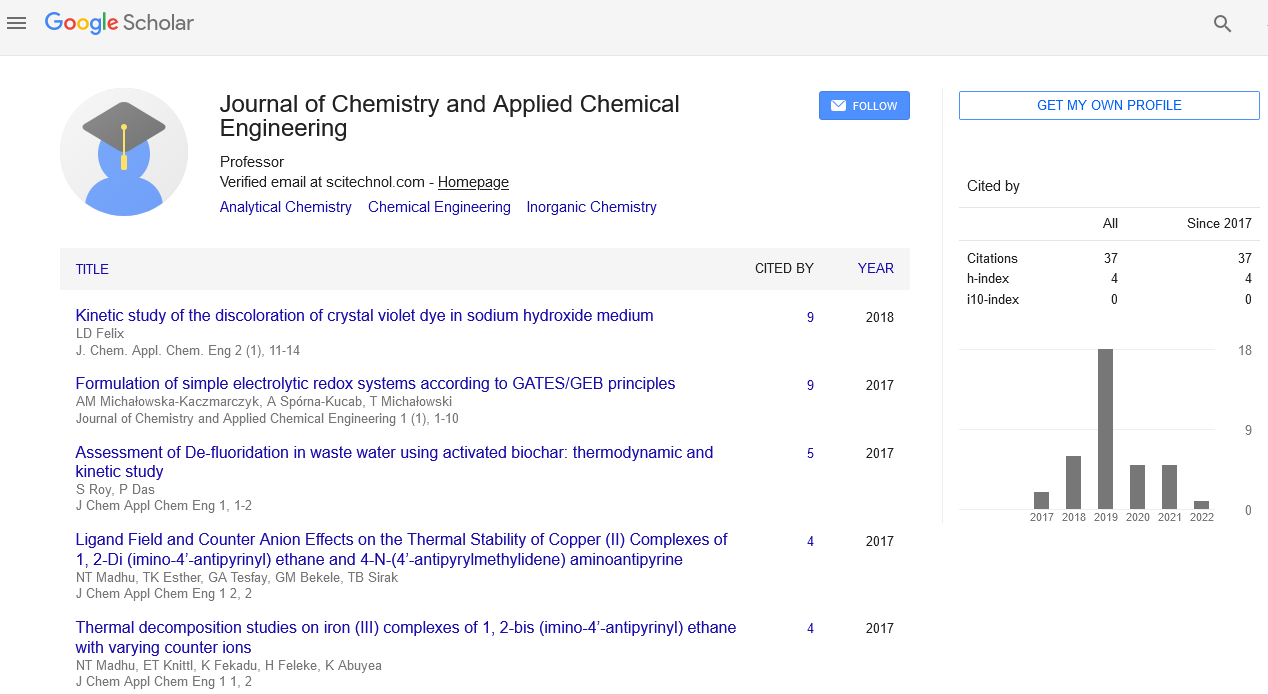Perspective, J Chem Appl Chem Eng Vol: 7 Issue: 1
Investigation of the Corrosion Behavior of Metals and Alloys in Severe Environments
Edoardo Jung*
1Department of Chemical and Biochemical Engineering, Dongguk University, Seoul, South Korea
*Corresponding Author: Edoardo Jung
Department of Chemical and Biochemical
Engineering, Dongguk University, Seoul, South Korea
E-mail: jung@edoardo.edu
Received date: 28 February, 2023, Manuscript No. JCACE-23-95548;
Editor assigned date: 03 March, 2023, Pre QC No. JCACE-23-95548(PQ);
Reviewed date: 17 March, 2023, QC No. JCACE-23-95548;
Revised date: 24 March, 2023, Manuscript No. JCACE-23-95548 (R);
Published date: 31 March, 2023, DOI: 10.4172/Jcace.1000e020
Citation: Jung E (2023) Investigation of the Corrosion Behavior of Metals and Alloys in Severe Environments. J Chem Appl Chem Eng 7:1.
Description
The corrosion behavior of metals and alloys in severe environments is an important area of study for materials scientists and engineers. Corrosion refers to the degradation of materials due to chemical reactions with their environment, and it can lead to significant economic and safety issues. Severe environments can include exposure to high temperatures, corrosive chemicals, and moisture. Understanding the corrosion behavior of metals and alloys in these environments is important for developing materials that can withstand these conditions.
There are several methods that can be used to investigate the corrosion behavior of metals and alloys in harsh environments. These methods can be classified into two main categories: non-destructive and destructive testing. Non-destructive testing methods are used to evaluate the properties of materials without causing any damage to them. Destructive testing methods, on the other hand, involve the destruction of the material being tested.
Non-destructive testing methods include techniques such as Electrochemical Impedance Spectroscopy (EIS), X-Ray Diffraction (XRD), and Scanning Electron Microscopy (SEM). EIS measures the electrical impedance of a material in response to a small alternating current. This allows the study of the kinetics of corrosion reactions at the metal-environment interface. XRD is a technique that uses X-rays to study the crystal structure of materials. It can be used to study the formation of corrosion products on the surface of metals and alloys. SEM is a technique that uses electrons to produce high-resolution images of the surface of materials. It can be used to study the morphology of corrosion products and the extent of corrosion damage.
Destructive testing methods include techniques such as weight loss analysis, corrosion coupons, and immersion testing. Weight loss analysis involves measuring the weight of a metal sample before and after exposure to a corrosive environment. The difference in weight is used to calculate the corrosion rate of the metal. Corrosion coupons are small metal coupons that are exposed to a corrosive environment and then removed for analysis. The extent of corrosion damage on the coupons is used to estimate the corrosion rate of the metal. Immersion testing involves immersing a metal sample in a corrosive environment for a fixed period of time and then removing it for analysis. The extent of corrosion damage on the sample is used to estimate the corrosion rate of the metal.
The choice of testing method depends on several factors, including the type of metal or alloy being tested, the nature of the corrosive environment, and the desired level of accuracy. In some cases, a combination of non-destructive and destructive testing methods may be used to obtain a more complete picture of the corrosion behavior of a material.
Once the corrosion behavior of a metal or alloy has been studied, the next step is to develop strategies for preventing or minimizing corrosion. These strategies can include the use of protective coatings, the selection of more corrosion-resistant materials, and the use of inhibitors.
Protective coatings can be applied to the surface of metals and alloys to prevent them from coming into contact with the corrosive environment. These coatings can be in the form of paints, plating’s, or thin films. The choice of coating depends on the nature of the corrosive environment and the properties of the metal or alloy being protected.
The selection of more corrosion-resistant materials is another strategy for minimizing corrosion. This can involve the use of alloys that are specifically designed to resist corrosion in certain environments. For example, stainless steel is often used in applications where resistance to corrosion is important.
Inhibitors are substances that can be added to a corrosive environment to reduce the rate of corrosion. They work by either forming a protective film on the surface of the metal or by inhibiting the chemical reactions that lead to corrosion. Inhibitors can be organic or inorganic compounds, and their effectiveness depends on the nature of the corrosive environment and the properties of the metal or alloy being protected.
 Spanish
Spanish  Chinese
Chinese  Russian
Russian  German
German  French
French  Japanese
Japanese  Portuguese
Portuguese  Hindi
Hindi 